Advertisement
Grab your lab coat. Let's get started
Welcome!
Welcome!
Create an account below to get 6 C&EN articles per month, receive newsletters and more - all free.
It seems this is your first time logging in online. Please enter the following information to continue.
As an ACS member you automatically get access to this site. All we need is few more details to create your reading experience.
Not you? Sign in with a different account.
Not you? Sign in with a different account.
ERROR 1
ERROR 1
ERROR 2
ERROR 2
ERROR 2
ERROR 2
ERROR 2
Password and Confirm password must match.
If you have an ACS member number, please enter it here so we can link this account to your membership. (optional)
ERROR 2
ACS values your privacy. By submitting your information, you are gaining access to C&EN and subscribing to our weekly newsletter. We use the information you provide to make your reading experience better, and we will never sell your data to third party members.
Policy
Sezen Found Guilty Of Fraud
Scientific Misconduct: Columbia University case is one of the worst for chemistry
by William G. Schulz
December 6, 2010
| A version of this story appeared in
Volume 88, Issue 49
The federal Office of Research Integrity (ORI) has leveled 21 findings of research misconduct against former Columbia University chemistry graduate student Bengü Sezen. Her case is one of the worst incidents of scientific misconduct to have hit the chemistry community.
The ORI findings validate Columbia’s own investigation. A notice in the Nov. 29 Federal Register states that Sezen falsified, fabricated, and plagiarized research data in three papers and her doctoral thesis. Some six papers that Sezen had coauthored with Columbia associate professor of chemistry Dalibor Sames have been withdrawn by Sames because Sezen’s results could not be replicated.
“Both ORI and Columbia concluded that Dr. Sezen fabricated most of her research while at Columbia,” says ORI’s director of investigative oversight, John E. Dahlberg. “For example, most of the spectra she produced to demonstrate the presence of chemical intermediates or final compounds were fabricated by pasting together fragments of irrelevant NMR spectra.”
“The University is in the process of requesting the trustees to formally revoke Ms. Sezen’s Ph.D.,” a Columbia spokesman said in a statement. Sames declined to speak to C&EN.
The case stretches back to 2005, when Columbia awarded Sezen her Ph.D. in chemistry. Working in the Sames laboratory, she claimed to have developed a method for selectively activating C–H bonds, a technique commonly used to functionalize hydrocarbons. Soon after the work was published, however, other researchers in Sames’s lab and elsewhere reported problems reproducing it. Ultimately, Columbia launched an investigation of Sezen.
Through it all, Sezen has maintained that her work is valid and that other researchers have been able to reproduce her experimental results. She objected loudly when Sames retracted the papers they had coauthored, and she has insisted that none of her results were faked. She went on to earn another Ph.D. in molecular biology at the University of Heidelberg, in Germany.
Sezen is no longer listed as a researcher at Heidelberg, and her current whereabouts are unknown.





Join the conversation
Contact the reporter
Submit a Letter to the Editor for publication
Engage with us on Twitter